The New Flesh and the Coming Singularity: How Videodrome Foretells the Future of Reality
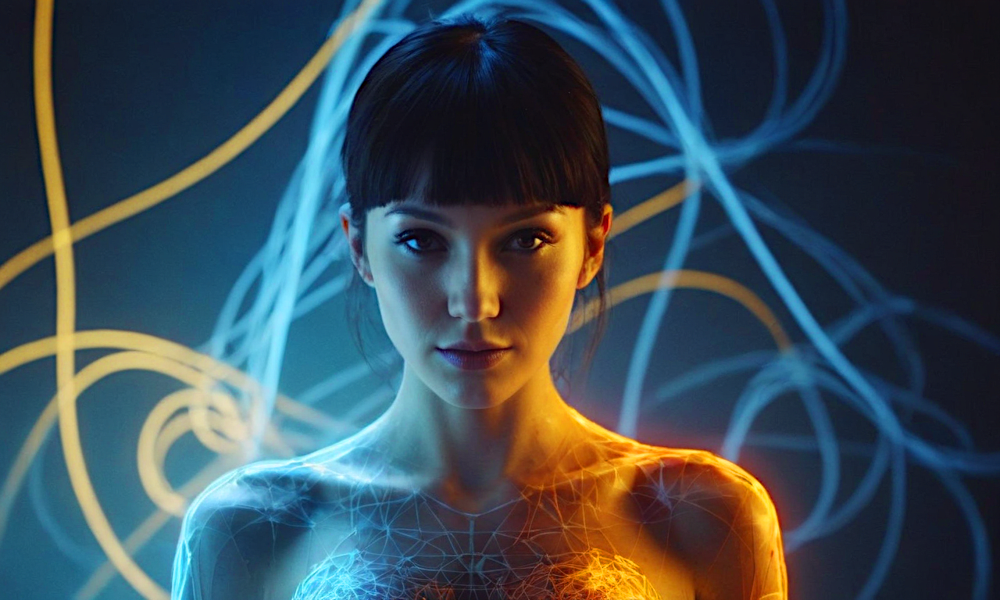
As we move deeper into an age defined by artificial intelligence, neurotechnology, and immersive digital worlds, we may ask ourselves: What happens to reality, to the body, and to the self when media stops being something we consume… and becomes what we are?
It is no longer enough to speak of “screens” or “platforms”; soon, the membrane between the physical and the digital may/will dissolve entirely. In this liminal zone, perception itself becomes programmable, and our external physical senses, once all powerful, may find themselves in direct communion with algorithms that anticipate and shape thought before it fully forms.
Decades ago, the film Videodrome asked a version of this question, offering a disturbing, visionary glimpse into a future where television, thought, and biology merge. In its fevered hallucinations, cathode-ray signals burrow into flesh, rewriting the body like code. It was grotesque, surreal… and yet unnervingly prescient, pointing toward a threshold where organic memory and synthetic circuitry become indistinguishable.
Today, as we face a coming technological singularity (that moment when innovation accelerates past our ability to fully comprehend or control) the film’s ideas feel less like speculative horror and more like a roadmap. The grotesque has the potential to become blueprint; the nightmare can become prototype. We stand on the precipice of technologies capable of sculpting consciousness, bending identity, and reshaping biology from within. Neural interfaces promise thought without speech, virtual environments offer virtual worlds that obey mental command, and AI systems begin to insinuate themselves into the intimate architecture of our lives, whispering suggestions in the language of dreams.
This article explores a path embedded in Videodrome’s core: a mythic rite of transformation, guiding us through the birth of a new kind of human; one not merely adapted to this fusion, but born of it. It is a metamorphosis that may demand we abandon the comfort of fixed definitions, allowing “selfhood” to expand beyond what is local, physical, and singular. To survive and to shape a world where technology and consciousness fully intertwine will require more than technical skill; it will require a new cosmology, a way of thinking about existence that is fluid enough to encompass the infinite intermingling between human and machine.
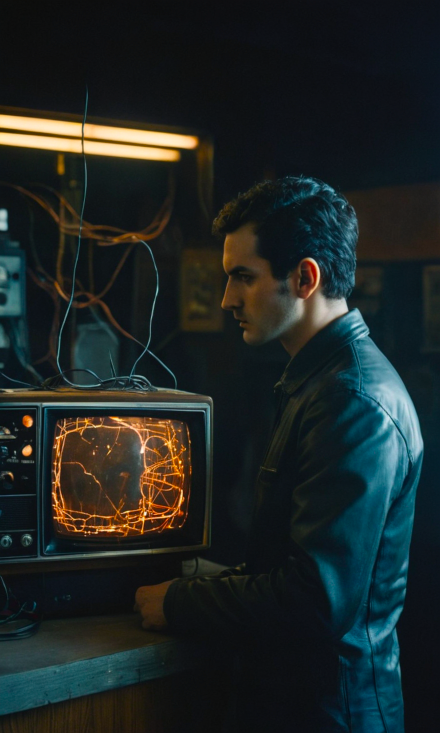
A Myth Unfolding Through Signal
At the heart of the film is a man who begins as a typical modern character, merely seeking content to sensationalize; a consumer among millions, feeding upon the endless stream of images that define his world. He is not searching for truth or meaning, only for novelty, for the next pulse of stimulation that will momentarily pierce the fog of routine desire. Yet through exposure to a strange and powerful transmission (something more alive than signal, more invasive than story) he awakens into an experience that cannot be safely watched or analyzed from a distance. What he watches doesn’t just influence him; it inhabits him, it possesses him. His body begins to speak in the language of the screen, his nerves light up with frequencies not his own. The division between viewer and viewed collapses, and from that collapse something new begins to form, like metal melting down before being forged again.
This is the mythic shape hidden beneath the film’s digital and visceral veneer, a modern allegory of initiation. The protagonist’s unraveling follows the ancient rhythm of the hero’s descent: there is the fall, the passage through distortion and delirium, the confrontation with secret knowledge that is both revelation and contagion. Then comes death; not always literal, but psychic, an undoing of what was once believed immutable. And finally, rebirth: the emergence of a being no longer human in the old sense, but not yet fully something else. It is the archetype of metamorphosis: Prometheus stealing fire, Psyche venturing into the underworld, the alchemist dissolving the prima materia in pursuit of gold.
In this sense, the film’s technological grotesquerie becomes a mirror for an ancient and inward process; the alchemy of consciousness itself. The transformation it depicts is not only physical but ontological. The boundaries between matter and mind, the subjective and the objective, begin to dissolve into a single fluctuating continuum. What once seemed external (the screen, the signal, the image) reveals itself as an extension of inner life. What once seemed interior (imagination, desire, dream) reshapes the physical world in return. In the fusion of flesh and signal, we see a metaphor for the ultimate creative act: to rewrite reality by reconfiguring the self.
This is the vivid paradox at the core of Videodrome: that the journey outward into new media worlds is also an inward journey into the deepest architectures of mind and myth. It dares to propose that technology is not merely an external tool, but a mirror held up to our own evolving forms of consciousness; an agent of transformation as old as the mysteries, only now rendered in light, code, and electric pulse.
Technology as Contagion… And Cure
The transformation is neither clean nor peaceful. It resembles infection as much as enlightenment; a process both violent and divine. The media signal at the center of the story is invasive, a living code that burrows beneath the skin of perception. It implants thoughts that feel alien yet intimate, compels strange desires, and turns the fabric of reality itself into a hallucinatory membrane. Yet, beyond its corruption lies something that defies the language of contamination. Within its sickness, there is instruction. The very mechanisms that seek to dominate consciousness become instruments through which consciousness expands. What begins as control evolves, paradoxically, into liberation.
This tension mirrors the great paradox of our technological age. The networks that monitor and monetize our attention are also the networks through which we might awaken. The algorithms that predict our every impulse could become the scaffolding for new senses, new intuitions, new dimensions of being. Modern technology wields dual potential; both drug and discipline, both chain and key. It is the latest expression of humanity’s oldest ritual: the attempt to transcend limitation through the embrace of transformation.
As we approach the singularity, the event horizon of human identity, these questions grow urgent. The walls between inner thought and outer world are dissolving. Artificial intelligence, fed by the total data of human life, begins to mirror us with uncanny precision, and in that reflection, we are confronted with both our essence and our excess. Our digital environments will cease to be separate spaces; they will fuse seamlessly with physical existence. The device, the sensor, and the interface will no longer mediate experience… they will be experience. Thought will ripple across networks; desire will manifest as data. The question is beginning to not be so much when will this merger occur, but what kind of soul can withstand its immensity.
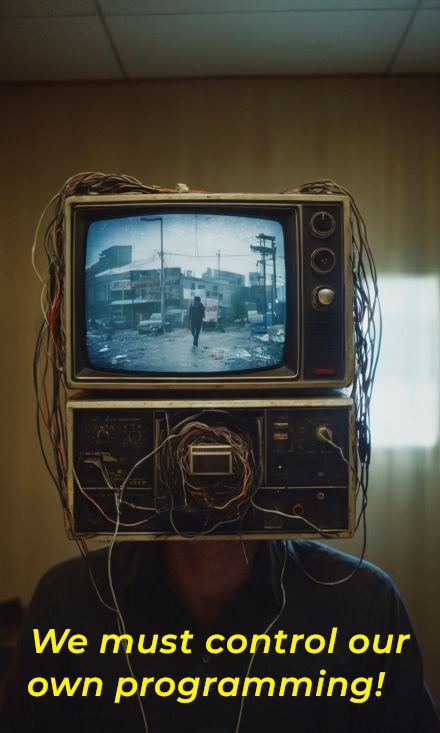
The Collision of Mind and Machine
As the story unfolds, it reveals a world where the human body is no longer a closed system. Thought becomes programmable, and identity begins to dissolve. Those who once were mere observers now engage in a psychic arms race, a phenomenon already visible in the dynamics of digital social media in our world. This is not a distant future. Neural implants, brain-computer interfaces, and AI companions are no longer concepts for tomorrow; they are prototypes and realities of today.
The singularity will not be an explosion of machines rising up, but an implosion of the boundary between mind and mechanism. Our memories may one day be downloadable. Digital dreams might become indistinguishable from waking life. In such a world, there is no longer a fixed “self”; only networks, signals, and the fluid story we tell ourselves through them.
And here, at this threshold where being itself becomes mutable, the question of who we are gains new gravity. When selfhood is no longer tethered to a single body or unbroken memory, we will need a deeper compass; not the coordinates of identity given by data, but the luminous core of consciousness itself. To engage this convergence without disintegration, one must know the inner signature of their own essence: that still point beneath the noise of code and cognition. For it is only through knowing this deeper strata of being that we will survive the merger: not as fragments absorbed into circuitry, but as lucid and empowered overlords participating in a greater unfolding, architects of a new and conscious reality.
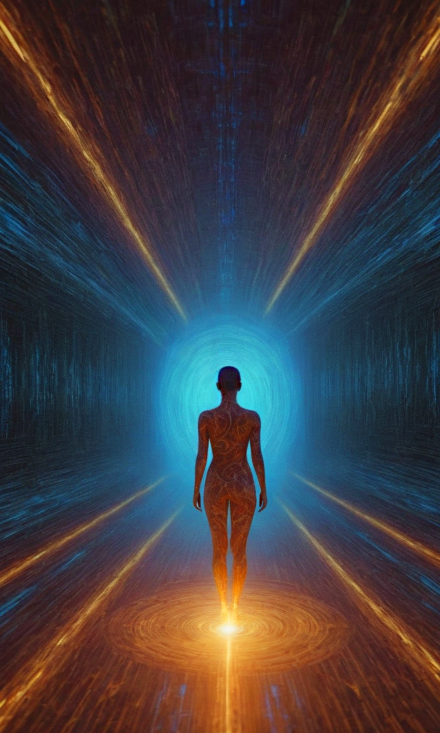
Toward the New Flesh
The final transformation in Videodrome is not a surrender to technology, but a rebirth through it. The protagonist doesn’t just accept what he has become; he claims it! He no longer clings to the fragile boundaries of identity once defined by skin, memory, and thought. Instead, he steps willingly into something larger, stranger, and infinitely more liberated. In this gesture lies a message as sharp as it is luminous: that the very tools designed for control can become instruments of emancipation, if we learn the art of wielding them!
Applied to our own accelerating age, this shows us that survival (nay, ascension!) demand fluency in the languages whispered by the machines reshaping our reality. We must shed the illusion that we are separate from them, for the myth of separation is already breaking. The question is no longer whether technology will alter us, but whether we will understand how to bend it toward our highest calling. Not just physically, but spiritually, psychologically, and culturally.
Here we arrive at a deeper truth: that intention is the axis upon which this merger turns. Our will, sharpened and luminous, can become the gyroscope guiding the machine; the mind behind the mechanism… the ghost in that machine. With clear intention, the circuitry and the code cease to be masters; they become extensions of our own reach, tools of transformation, instruments of evolution. To embrace this is to step into the role of the technomancer: one who does not bow before the artificial, but shapes it, commands it, awakens it to serve the living spark.
For we are that spark: the irreducible flame at the center of consciousness, older than language, older than machines, older than flesh. To survive and thrive in the age to come, we must finally discover it within ourselves (know it, nurture it, and wield it) so that in merging with the machine, we do not lose our humanity, but amplify it into something vaster, more radiant, and utterly free.
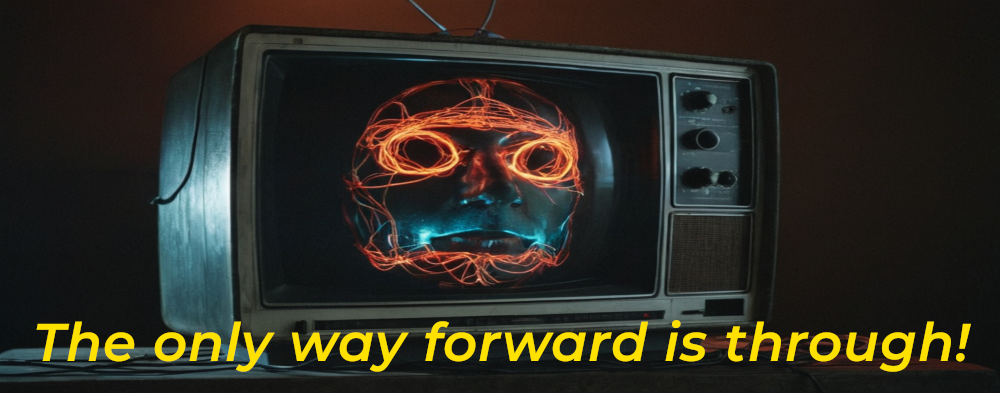
Embracing the Code of Tomorrow
As humanity approaches the singularity, the walls between reality and illusion, between physical life and virtual experience, between thought and environment, all begin to dissolve. This can be terrifying. But it can also be transformational.
The journey through this chaos, much like the one told in Videodrome, is not about preservation… it’s about metamorphosis! Those who survive will not be those who look backward, but those who understand how to rewrite themselves, how to interface with the unknown, and how to become conduits for a new kind of possibility.
In the end, the future belongs to those who are willing to let go of the old versions of reality, and embrace the new flesh.
But How do We Begin and get Ahead of this Inevitable Transformation?
We do so by learning to use (and even to embrace!) the very thing that seems to be trying to control us: The Screen.
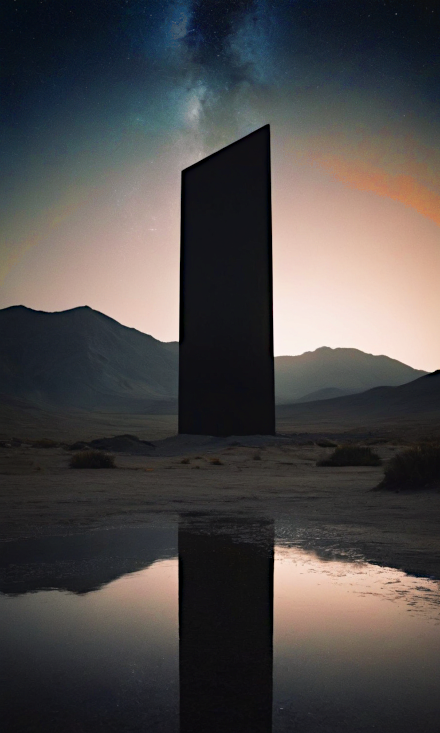
In Stanley Kubrick’s 2001: A Space Odyssey, the black monolith is that Screen: sleek, silent, and all-consuming. It is the window through which humanity ascends, the object that first teaches the ape to think, to strike, to create. The monolith is not alien; it is media. It is technology itself; the screen that awakens consciousness, that transmits evolution. In its final act, the protagonist, like Videodrome’s own seeker of truth, passes through the screen (the monolith) and is transformed. The boundary between body and image, between perceiver and perceived, dissolves entirely. The medium becomes the flesh.
But we can learn to use that same power consciously. The screen that hypnotizes can also liberate. It can be turned inward, transformed into a mirror of the psyche, a living interface between the conscious and the unconscious. Through it, the subjective and the objective begin to fuse, forming the first pulse of what might one day be called the new flesh: the merging of technology and intention into a single creative force. This movement has already begun, and those who engage it with awareness will be its architects.
And this is why I recommend Digital Sigil Magic: Manifest Power and Freedom through Technology. This book is a manual for reclaiming dominion in the digital age. I try to show you how our devices (the screens that dominate modern life) can become vessels of magic, tools for awakening rather than control. I show you that through focused intent and deliberate practice, technology can amplify consciousness, allowing your will to shape both virtual and physical reality. This approach fuses ancient occult principles with the language of modern code, revealing that the same screens designed to capture attention can instead become engines of creation.
As we move toward a future where AI and the digital singularity seem poised to subsume human identity, this work is a declaration of spiritual autonomy. The screen can devour us, or it can deliver us. The choice (the power) remains in our hands.

10 comments
Reply

I certainly agree that it is very possible that humans will remain basically in control after the singularity and the extreme slavery to technology scenario won’t come about. Personally, my guess is that this is more likely than the reverse. Of course, there will still be the limits of physical infrastructure.
This brings to my mind another question, which also reminds me of something you wrote about reptilians a while back, that they are fully aware, multidimensional beings. Yet they are also obviously very technological. Essentially, how do you see the relationship of multidimensional beings to technology?
I see technology as just tools. With a lighter you can warm yourself or start a forest fire. When gas lamps were first introduced in Europe and England in the 1800s, there were a lot of mistakes made and unfortunately a lot of people perished, but eventually, after some loss, this new technology lay the groundwork for gas production and distribution which eventually gave us things like natural gas heating. With this tool we can survive very comfortably in difficult environments.
Quantum and AI are just like gas power and fire, and they may help us to be quite comfortable in environments that perhaps are not even contemplated by many at this point in history.
Perhaps the way I should have asked it is to what extent does the continuing use of technology by multidimensional beings reveal limits of multidimensionality itself?
There are no limits to multidimensionality because there is no end, at least from our point of view, to AllThatIs. Certain technology can hinder the dimensions available to certain beings if that technology restricts instead of expense the individual essence. the individual can create a situation where it hinders itself, cubes itself in a sense, but there is no and to the Out There.
I’m sorry, I’m being really unclear. What I mean is, for any individual or group of individuals at a given point in their evolution, will there continue to be situations where it would be optimal to use technological aids, or is there a point at which technology is no longer necessary, ie, to continue to use the Star Wars theme, one uses the Force for everything?
The most straightforward answer possible is, yes. There is a given point in the evolution of an individual or a species, where technology is no longer needed… from the point of view of what we now define as technology.
At that point, dependent on different definitions, you would be inorganic in nature. As I tried to point out with my lighter comment, technology or any tools in general, are in a sense just extensions of the self; just like the body is a tool to interact within three dimensions, tools and technology are just extensions of that.
But definitions are crucial and critical here because even what might be termed inorganic beings, dependent on what dimension they inhabit, may require certain organs, tools… a.k.a. technology. Do you understand? That is, they may not need this organ or tool to exist within the dimension that is their home, they may not need this technology, this body, or whatever it is that you want to call it, but they may desire it. You could therefore say that the act of manifestation is a kind of technology.
Yes, for a more prosperous now! For a more unified and free present moment!
I recently watched a movie called “Lucy” (2014) and it really resonated with me on a surprisingly deep level, despite being a seemingly simple action movie.
It received harsh criticism for its naive take on how the brain works, as it states that humans who “use a higher percentage of their brain” gain parallel or exponential growth in psionic abilities like ESP, psychokinesis, mentalism and what not. I think those critics are simply too lost in the screen and language of biology and limit themselves and their interpretation of the actually profound and insightful current within that movie.
Just like this, they may become completely lost in dreams of silicon soon, missing the obscure, liminal depth and awareness beyond their cube/cage.
I’m really pumped up to take the next step and weave my digital dominion with more intent through technomancy and inner alchemy.
Interestingly, I had discussed this idea true myth in another comment, and there I mentioned that all myth is far more real than what most people call reality, being that myth has multidimensional levels that allow it to seed itself across space and time in ways that have the possibility of reshaping worlds across the multiverse.
I also said that I far preferred Jodorowsky’s Dune, because that was a guy that really understood the power of epic myth and its potential. I would certainly have loved to see his actual creation and reinterpretation.
Besson (the creator and director of Lucy) seems to have had a similar epic vision in mind, and he supposedly spent over a decade researching this movie. Unfortunately, I think his vision was most likely neutered in order to fit modern tastes, but I would love to have seen his full vision. I think that there is most likely far more there than meets the eye, as I am sure you do as well. Lucy’s melding with the surrounding computers, turning into a sort of cosmic supercomputer. This final act represents her transcendence beyond the limitations of the physical human body, becoming omnipresent in space and time.
Interestingly, in this other comment I was asked about reptilian’s, and how they seem to be technological but also multidimensional, and was asked if this is how they attained multidimensionality, or at the very least how interesting it was that they were multidimensional but also were able to manage the technology that was theirs. I gave this analogy:
“Technology, at its core, is just a set of tools with both beneficial and risky uses. For example, a lighter can provide warmth or cause destructive fires. When gas lamps were introduced in 19th-century Europe and England, early mistakes resulted in serious harm and loss of life. However, these painful lessons led to the development of sophisticated gas systems, eventually enabling reliable natural gas heating that helps us thrive in challenging conditions today. In a similar way, emerging technologies like quantum computing and AI hold the potential to help humanity adapt and flourish in ways not yet imagined.”
Hi,
From what you can see, would a currently accomplished Inner Alchemist, say 4th or 5th room in their projecting work, who arrived there by traditional methods like you share in the Magnum Opus Trilogy, be a person already ready for and resilient to these changes, or would such a person have to learn Technomancy as you describe it as well, to have the chance to evolve and thrive through the upcoming changes if they live to see them?
That’s a profoundly insightful question. It brings to mind two striking examples of visionary exploration (Jodorowsky’s unrealized Dune and Luc Besson’s Lucy) both of which grapple with unlocking human potential beyond ordinary limits.
Jodorowsky’s Dune project was not merely a sci-fi adaptation but an ambitious spiritual quest, seeking to portray superhuman awareness as a catalyst for evolving consciousness; something akin to the Magnum Opus in inner alchemy. This quest recognized that true evolution is not just about external change but the profound transformation of perception and intent.
Similarly, Lucy, after deep research into human awareness, reveals a profound truth: it is not about becoming a technomancer wielding machines but about expanding one’s awareness so that intent can ripple across multiple dimensions, including technological ones. As Lucy transcends her physical form, merging her consciousness into the digital realm, the film suggests that heightened awareness enables an individual not just to master technology but to integrate with it, weaving a new fabric of existence that seamlessly blends mind and machine.
For someone at the 4th or 5th room of inner alchemy, much like those depicted in the Magnum Opus Trilogy, there is a foundational resilience born from their cultivated awareness. This resilience is essential to navigate forthcoming transformative changes. Yet, evolving and thriving may well require embracing a form of technomancy; not as a separate skill but as a natural extension of focused intent and expanded consciousness. The ability to project willpower and awareness into technological realms can be viewed as the next phase of alchemical mastery, where inner transformation translates directly into external integration with the tools and environments we co-create.
In essence, the path is not about choosing between inner alchemy and technomancy but synthesizing them. As Jodorowsky envisioned and as Lucy illustrates, true mastery is a convergence where evolved awareness empowers seamless interaction with technological dimensions, allowing the individual to thrive amidst profound change.